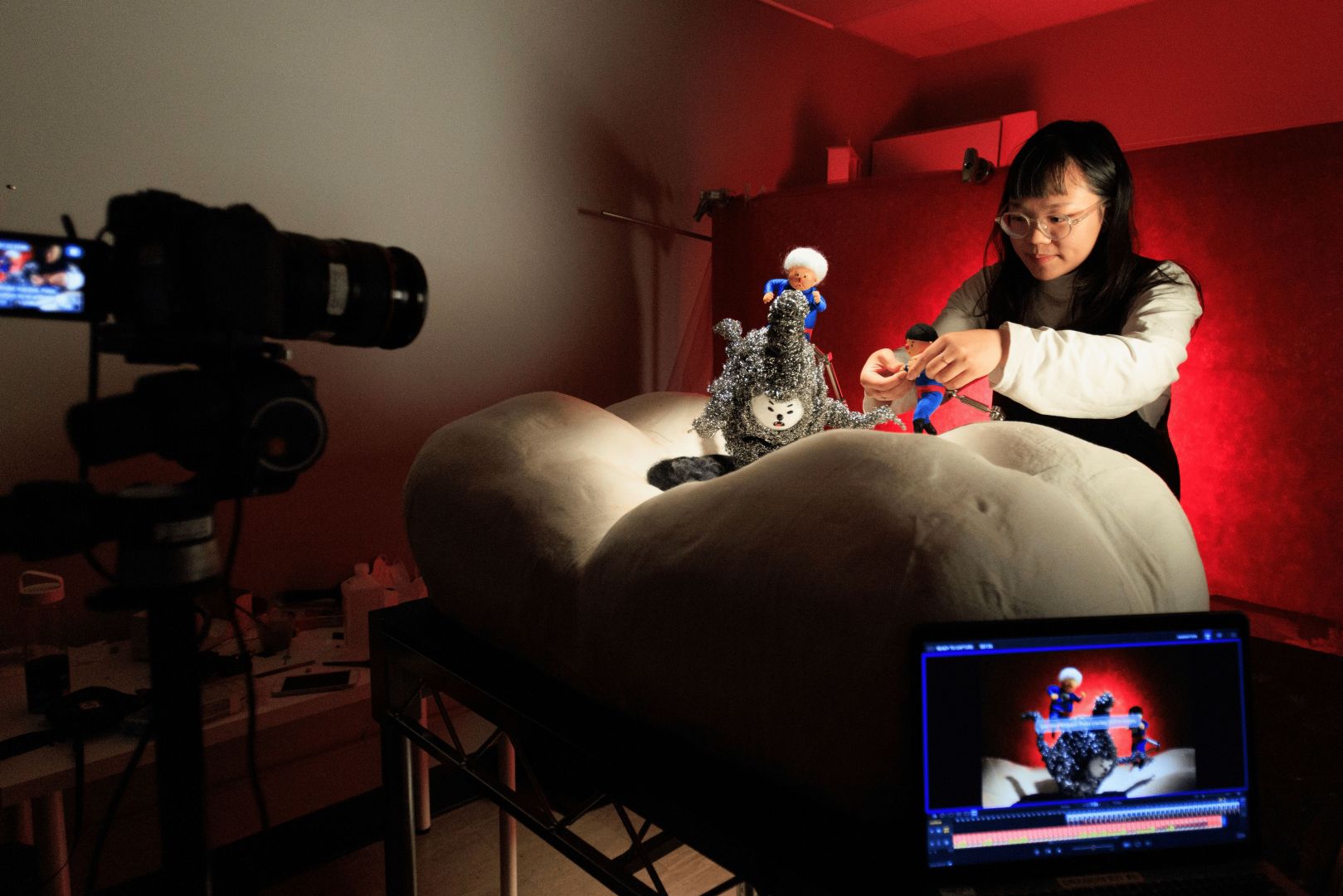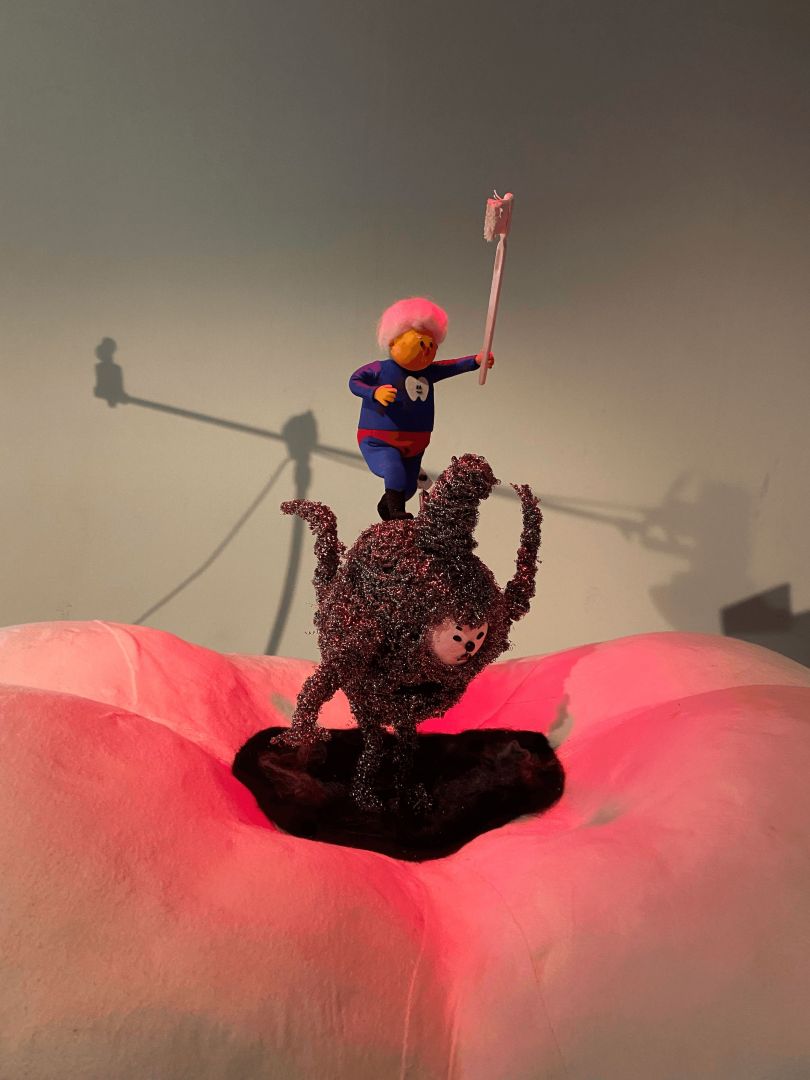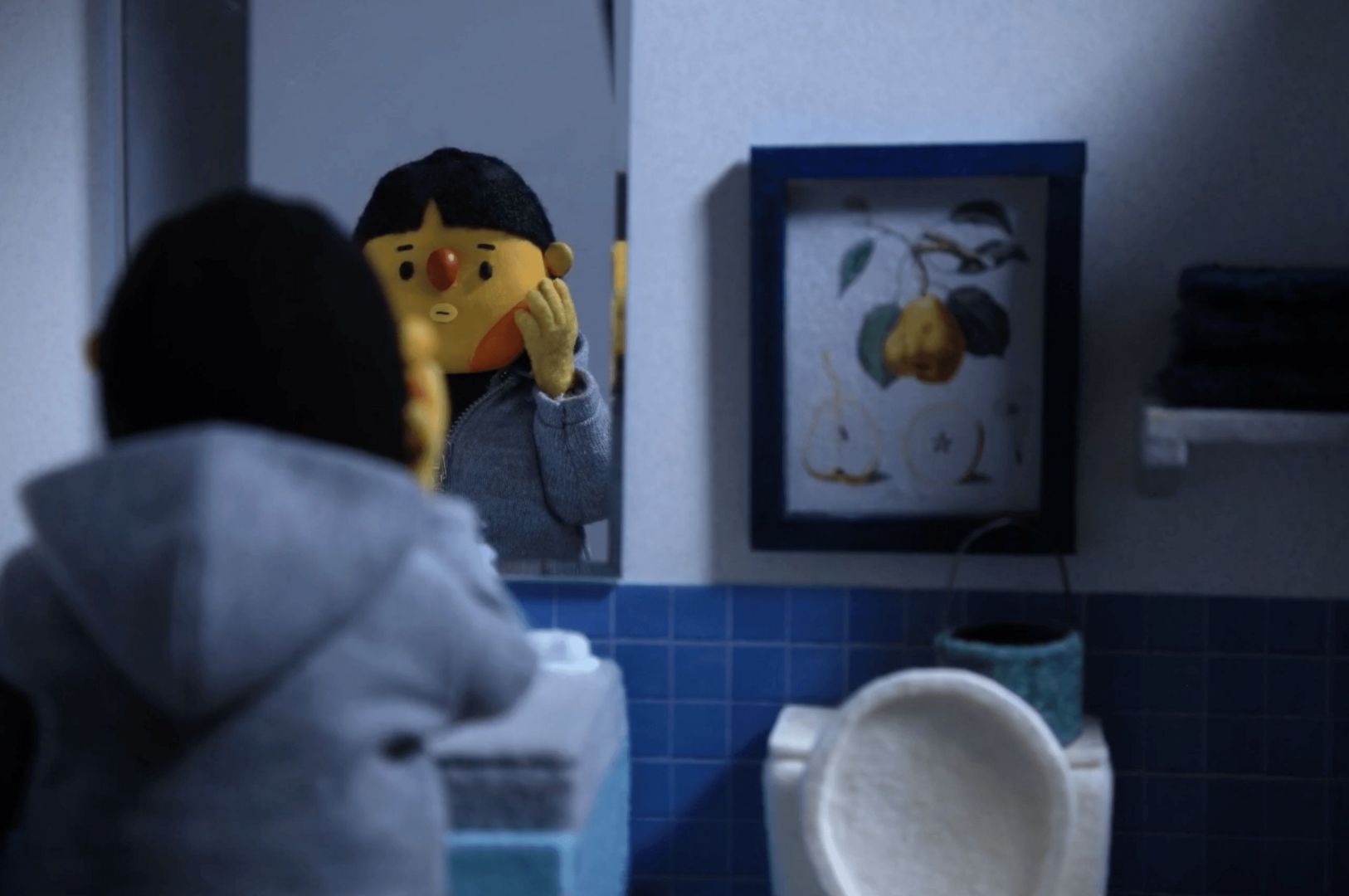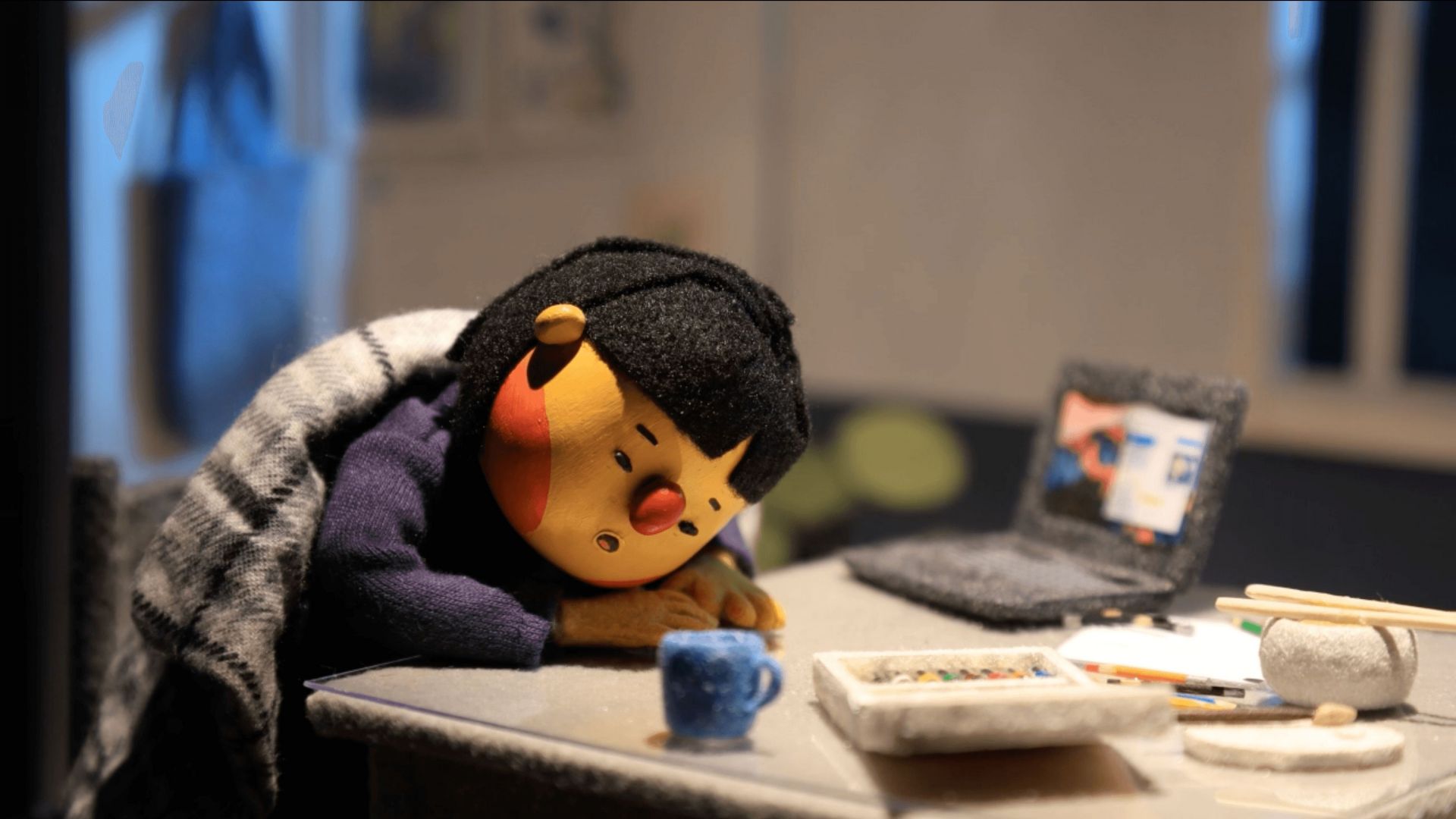Meet Joan Hui Ko | Stop Motion Artist & Teaching Artist

We had the good fortune of connecting with Joan Hui Ko and we’ve shared our conversation below.
Hi Joan Hui, why did you pursue a creative career?
I have always had a passion for arts that involve physical materials and textures. One of my earliest memories of creating art as a child is from a found object collage project in second grade. We were given cotton, toothpicks, Elmer’s glue, colored paper, and crayons and asked to create a mixed media collage with these materials. While my classmates copied the art teacher’s demonstration to paste the cotton on the paper to mimic clouds and line up toothpicks to build a house, I used the cotton to create a flock of sheep and the toothpicks to form the fences for a barn. My art teacher was so impressed by my creativity and unique use of materials that it became a defining moment for me in realizing my love for art and innovation. Since then, my love for tactile experiences in art has only grown. I wanted to find better ways to show the quality of natural materials such as wood, leaves, husk, wool, and clay in my artwork. This pursuit took a significant turn during my time in college when I was first introduced to stop motion and the unlimited possibilities it offers.
As an independent stop motion artist, I handle every aspect of the filmmaking process, from script writing to visual development, puppet and set fabrication, animation, and post-production. The part of the process I enjoy the most is experimenting with different materials—the most fundamental element of fabrication—to see what best enhances the story. To me, texture is a form of nonverbal language that can only be perceived by touch. Not only do I embrace the tender quality of tactile material, but also amplify its gentle characteristic through subtle movements when animating. The texture itself, the slight jitter it creates when lightly brushed on the surface frame by frame, quietly yet vitally breathes, vibrates, speaks, and comes to life in my work.
Experimenting with various materials has become a significant aspect of my art practice. Mixing and matching different objects and techniques often lead to unexpected results, sparking new creative avenues. This approach ensures that my work remains fresh and continually pushes the boundaries of my creativity. In mainstream art-making, there’s a predominant focus on achieving dramatic visual impact to captivate audiences. Yet the inadequacy of vision limits the ability of tactile perception, the eyes of the skin, to perceive the essence of the artwork. As I advance in my art career, I am consistently learning how to enhance our sense of touch and utilize it as a storytelling tool in stop motion. My goal is to convey stories that have gone unheard, enriching my narrative through tactile experiences.


Let’s talk shop? Tell us more about your career, what can you share with our community?
I’m a stop motion artist specializing in fabricating armature puppets and miniature sets from scratch. In my personal art practice, I place significant emphasis on the materials I use in my stop motion work, as their properties add layers of meaning to the storytelling. Wool, felt, and soft fabrics are commonly seen in my artwork because I prefer tender and soft materials to create dreamy effects, especially when depicting cherished memories from the past. Another aspect I enjoy exploring in stop motion fabrication is the concept of wabi-sabi, an aesthetic often described as appreciating beauty that is ‘imperfect, impermanent, and incomplete’ in nature. All materials in this world age, decay, and decompose over time, and this becomes evident as my puppets sit on my shelf for years after I’m done animating them. As time passes, for example, the colors of the orange peels I use in fabrication dry out and change. Instead of stressing about preserving my work in its original form, I allow time to leave its traces, embracing it as the natural process of the life cycle. I often view the morphs and changes in my puppets as a collaboration between me and time.
When working as a fabricator in the stop motion industry, I shift my focus from the fine art aspect of stop motion to more technical skills. I was fortunate to join Apartment D, a Los Angeles-based stop motion studio, as a puppet fabricator right after graduating. During my time with Apartment D, I worked on stop motion series for clients like Lego, American Girl Doll (Mattel), Monster High (Mattel), and commercial projects for clients like Jack in the Box.
One of the biggest challenges of being a freelance stop motion fabricator is efficiently communicating with and understanding the client’s needs while adding artistic touches to elevate the final result. I remember when my coworkers and I had to remove 80 American Girl doll limbs and all the cotton stuffing, then insert armature wires inside the limbs and replace the cotton with resin body blocks. This was essential because the aluminum wire is the key to making an American Girl doll animatable. I often joke with the puppet team that we are puppet engineers, as we constantly run into issues and have to find ways to reconstruct the dolls in a very short amount of time. Working on a production to meet a deadline can make stop motion very labor-intensive and sometimes almost too draining to sustain as a 9-to-5 job.
There’s a saying that a hobby is no longer a hobby when it turns into a real job, and that’s exactly how I felt halfway through the American Girl doll production. I remember feeling so drained and unmotivated to work on my personal projects after work, wanting to use all my non-working time to rest and do nothing. Balancing work and life, especially when both involve art making, can be very tricky. To make it more bearable, I asked for different tasks every day. Sometimes I would be cutting brass tubes in the morning and lashing armature wires in the afternoon. Other times, I would be attaching tie-downs to the doll’s feet and doing hair last looks with combs and hair spray. The process was repetitive, yet every time I constructed a fully animatable puppet, I learned something new that I hadn’t encountered before. Keeping an open mind and learning humbly from the process helped me through the entire production. I am and always will be thankful for the experiences I had at Apartment D.


Let’s say your best friend was visiting the area and you wanted to show them the best time ever. Where would you take them? Give us a little itinerary – say it was a week long trip, where would you eat, drink, visit, hang out, etc.
What makes Los Angeles culture so special is its deep connection to the Hollywood film industry, which adds a touch of romanticism to everything I do here as a film enthusiast. When I hike at Griffith Park and see the entire cityscape at night, I think about how Sebastian walked Mia to her car in La La Land. Driving along the narrow and curvy routes of Mulholland Drive reminds me of the thrilling scenes from the movie Mulholland Drive. When I crave a bowl of sul long tang soup, I head to Hanbat in Koreatown and remember how Danny from Beef took his parents there as soon as they arrived from Korea. If I were to recommend things to do for a friend visiting LA, I would suggest exploring its unique, rich and vibrant culture that can’t be found anywhere else.


Who else deserves some credit and recognition?
I have always believed in giving back to the community, which is why I became part of the CalArts Community Arts Partnership (CAP), a nonprofit organization that offers free after-school and school-based arts programs. I started working with CAP right after graduating from CalArts as an Animation Instructor, and it has been a life-changing experience that marked the beginning of my journey as a teaching artist.
I am very grateful to Veronica Alvarez, the Executive Director of CAP, for giving me this opportunity despite my limited work experience at the time. She believed in my artistic abilities and provided me with invaluable guidance on classroom management and teaching skills. My experience at CAP led to my second teaching job at a private high school as an animation faculty member. Under the supervision of the department chair, Anna Wadman, I received patient and understanding guidance, which greatly supported my development as a teaching artist.
Anna’s mentorship has been instrumental. She has taught me teaching skills and ways of viewing life and overcoming obstacles. Anna showed me that being a teaching artist is one of the fastest ways to learn new things about art and animation, as I must constantly keep up with various modern tools and techniques, embracing continuous learning. Teaching, like art-making, requires a commitment to lifelong learning. I deeply appreciate Anna’s belief in me and all her guidance and support.
Lastly, I would like to thank my mother and my aunt for their unwavering support, both financially and emotionally, which allowed me to study animation abroad. While they initially hoped I would choose a major leading to a financially stable job, they ultimately supported my passion for art. Being an artist requires a great deal of courage, and I draw much of my strength from my mom and aunt as I navigate the instabilities and ups and downs of this artistic career.
Website: https://www.joanhuiko.com
Instagram: https://www.instagram.com/joanhuiko/
Linkedin: https://linkedin.com/in/joan-hui-ko-843058163


Image Credits
Rafael Hernandez-Ispache
Jessica Haye & Clark Hsiao
